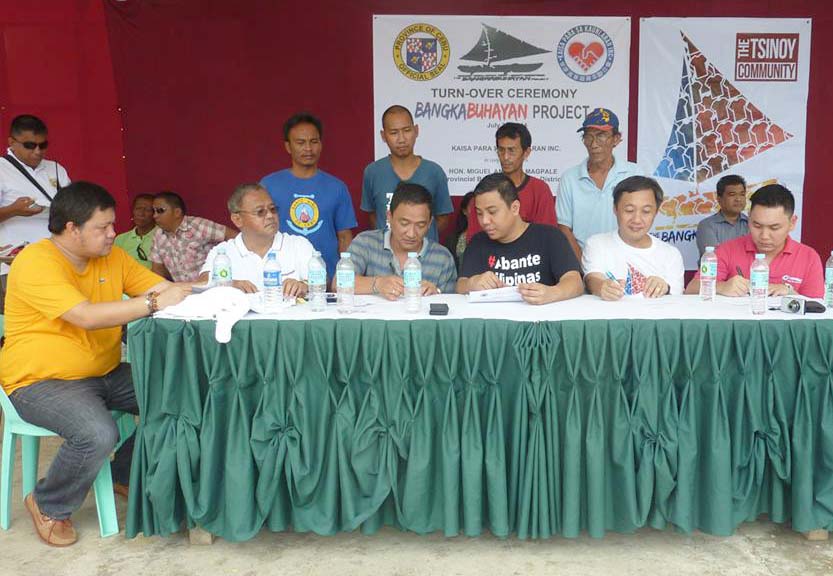First published in Tulay Fortnightly, Chinese-Filipino Digest 27, no. 6 (August 19-September 8, 2014): 11.
July was a very busy month for Kaisa Para Sa Kaunlaran’s Bangkabuhayan project volunteers, with several turnovers of boats and fishing gear to fisherfolk in barangays affected by Typhoon Yolanda (Haiyan) last November.
Further complications arose when the fiberglass boat factory in Bacolod City stopped production temporarily to accommodate sugar planting season. This resulted in a long waiting line of nongovernment organizations for the boats.
In lieu of boats, Kaisa decided to supply fisherfolk from three barangays of Balete, Aklan with marine plywood, regular lumber, marine epoxy and copper nails, and the boat engine. These will enable recipients to finish building their own boats.
The turnover of 24 boats for Batad, Iloilo was not without its problems. Kaisa volunteer Ganny Tan noted no preparations were done for the turnover ceremonies. He and Gilbert Valderrama, administrator of Philippine Red Cross-Iloilo Chapter, arrived at the Batad municipal office on July 3, the day of the turnover, with no idea whom to talk to.
The mayor, Pedro Alarcon, had texted Valderrama the night before that he was leaving for Manila for a medical checkup. The two went from department to department looking for their contact person.
It turned out the person dealing with all the logistics for this project was Cheryl Jelo, staff of the Bureau of Fisheries. But she was confused as well because the mayor did not tell her he was going to be away.
The boats were stored in a damaged gym, but Barangay Binon-an personnel needed further instructions for setting up the stage and sound system, providing tables and chairs and setting up a tarp for the roofless gym.
Since barangay personnel are beneficiaries as well, Tan advised them to organize themselves as a group and elect officers.
When the three arrived in Binon-an, the stage was prepared as per Tan’s instructions. The boats were there, but the engines were still in the barangay hall.

Jelo spent some time looking for the barangay chairman to advise him on how to arrange the boats for the turnover.
Fortunately, Kaisa’s reliable partners, Iloilo Citizen’s Action Group and Fire Brigade and Red Cross personnel, were there to help.
Kaisa volunteer Jonah Martin found many changes in the list of beneficiaries, so her morning was spent changing names in the Kasunduan to match the beneficiary list.
Barangay officials said many beneficiaries backed out after learning that they have to commit to Kaisa’s pay-it-forward policy.
Kaisa is the only nongovernment organization that requires beneficiaries to put up a cooperative and devise a pay-it-forward scheme by coming up with their own plans for sustainability and to help their own communities.
In Ajuy, the fishermen-beneficiaries have decided to contribute a specific monetary amount that will go into a communal fund.
The money will fund minor boat repairs, and hopefully, in the future, generate livelihood opportunities for fishermen’s wives.
Before the program started, Tan gave the 24 beneficiaries a quick briefing on minor boat repair and gave contact persons and members in case of engine problems.
As part of Kaisa’s participatory consultations, he sat down with Elpidio Franco Jr., president of the newly-formed United Fisherfolks Association, to discuss their pay-it-forward scheme.
The beneficiaries plan to contribute P2 a day initially to the association. Its first project is to buy one Kenbo engine unit to serve as a spare.
Valderrama will help monitor this group’s progress and assist in their planning and implementation.
Things ran more smoothly at the turnover of boats on July 29 in Eastern Samar. Kaisa volunteer Anabel Chua-Lim prepared all the logistics beforehand with our Samar partner, Health Futures Foundation Inc. (HFI), headed by Dr. Jaime Z. Galvez Tan, former secretary of the Department of Health. The plan was to turnover everything in one day (see story on p. 12).
Lim almost backed out when she realized she would fly to Tacloban on a propeller plane, not a jet. Fortunately, Eden Cheng, another Kaisa volunteer, was on hand to offer encouragement. Anabel gritted her teeth, took the five steps needed to board, and they were off.

From Tacloban airport to Samar, the driver had only one special instruction: watch out for a girl waiting for the Kaisa team by the roadside.
Everyone laughed at the vague instructions and the mood lightened. The team did find the girl: Jealyn Valenzuela, an HFI staff.
The program at Barangay San Roque, Marabut, Eastern Samar started at 8:30 a.m. Mayor Percival Ortillo attended the event and local barangay head Rupert Ambil, who manufactured the boats intended for Samar, and barangay staff taught the fishermen how to install the engines and care for the boats.
The one-hour program started and finished on time. By 10:00 a.m., the team was at Lawaan to inspect the six boats intended for fishermen there, while one boat is destined for a fisherman of Balangiga.
Half an hour later, the team arrived at Giporlos to check out nine more boats.
A little before noon, the Kaisa-HFI team was at Quinapondan for the turnover of 19 boats. The mayor and vice mayor were on hand to welcome them. The program finished in one hour as well.
In Samar, everything went like clockwork. The program partner did most of the work on the ground: they organized the fisherfolk and discussed the pay-it-forward scheme beforehand. They also arranged the turnover ceremonies, and ensured that local government officials are also on board with the project.
It seemed the Bureau of Fisheries was more invested in the project. One beneficiary told Tan, “Akala namin wala na, kasi matagal na.”
These are the people who really need more help because their own officials are indifferent and absent from their lives. In such instances, Kaisa is happy to be present and of service.